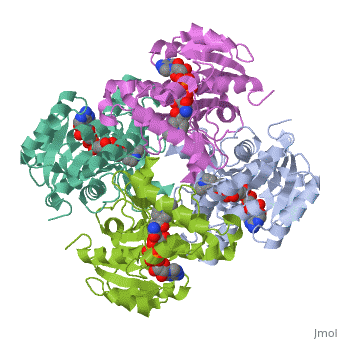2h9i
From Proteopedia
Mycobacterium tuberculosis InhA bound with ETH-NAD adduct
Structural highlights
FunctionEvolutionary ConservationCheck, as determined by ConSurfDB. You may read the explanation of the method and the full data available from ConSurf. Publication Abstract from PubMedThioamide drugs, ethionamide (ETH) and prothionamide (PTH), are clinically effective in the treatment of Mycobacterium tuberculosis, M. leprae, and M. avium complex infections. Although generally considered second-line drugs for tuberculosis, their use has increased considerably as the number of multidrug resistant and extensively drug resistant tuberculosis cases continues to rise. Despite the widespread use of thioamide drugs to treat tuberculosis and leprosy, their precise mechanisms of action remain unknown. Using a cell-based activation method, we now have definitive evidence that both thioamides form covalent adducts with nicotinamide adenine dinucleotide (NAD) and that these adducts are tight-binding inhibitors of M. tuberculosis and M. leprae InhA. The crystal structures of the inhibited M. leprae and M. tuberculosis InhA complexes provide the molecular details of target-drug interactions. The purified ETH-NAD and PTH-NAD adducts both showed nanomolar Kis against M. tuberculosis and M. leprae InhA. Knowledge of the precise structures and mechanisms of action of these drugs provides insights into designing new drugs that can overcome drug resistance. Mechanism of thioamide drug action against tuberculosis and leprosy.,Wang F, Langley R, Gulten G, Dover LG, Besra GS, Jacobs WR Jr, Sacchettini JC J Exp Med. 2007 Jan 22;204(1):73-8. Epub 2007 Jan 16. PMID:17227913[1] From MEDLINE®/PubMed®, a database of the U.S. National Library of Medicine. See AlsoReferences
| ||||||||||||||||||||


